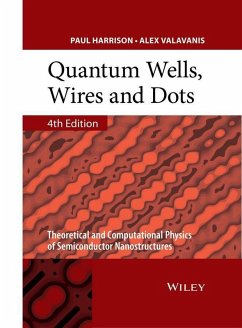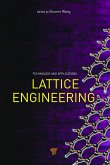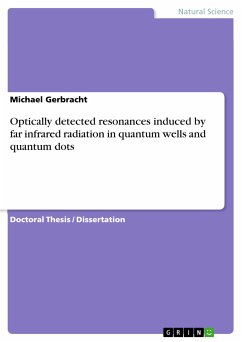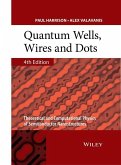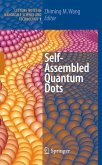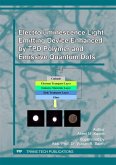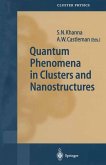Quantum Wells, Wires and Dots (eBook, PDF)
Theoretical and Computational Physics of Semiconductor Nanostructures


Alle Infos zum eBook verschenken

Quantum Wells, Wires and Dots (eBook, PDF)
Theoretical and Computational Physics of Semiconductor Nanostructures
- Format: PDF
- Merkliste
- Auf die Merkliste
- Bewerten Bewerten
- Teilen
- Produkt teilen
- Produkterinnerung
- Produkterinnerung

Hier können Sie sich einloggen

Bitte loggen Sie sich zunächst in Ihr Kundenkonto ein oder registrieren Sie sich bei bücher.de, um das eBook-Abo tolino select nutzen zu können.
Quantum Wells, Wires and Dots provides all the essential information, both theoretical and computational, to develop an understanding of the electronic, optical and transport properties of these semiconductor nanostructures. The book will lead the reader through comprehensive explanations and mathematical derivations to the point where they can design semiconductor nanostructures with the required electronic and optical properties for exploitation in these technologies. This fully revised and updated 4th edition features new sections that incorporate modern techniques and extensive new…mehr
- Geräte: PC
- mit Kopierschutz
- eBook Hilfe
- Größe: 13.44MB
![Lattice Engineering (eBook, PDF) Lattice Engineering (eBook, PDF)]() Lattice Engineering (eBook, PDF)97,95 €
Lattice Engineering (eBook, PDF)97,95 €![Luminescence (eBook, PDF) Luminescence (eBook, PDF)]() Luminescence (eBook, PDF)97,95 €
Luminescence (eBook, PDF)97,95 €![Optically detected resonances induced by far infrared radiation in quantum wells and quantum dots (eBook, PDF) Optically detected resonances induced by far infrared radiation in quantum wells and quantum dots (eBook, PDF)]() Michael GerbrachtOptically detected resonances induced by far infrared radiation in quantum wells and quantum dots (eBook, PDF)39,99 €
Michael GerbrachtOptically detected resonances induced by far infrared radiation in quantum wells and quantum dots (eBook, PDF)39,99 €![Quantum Wells, Wires and Dots (eBook, ePUB) Quantum Wells, Wires and Dots (eBook, ePUB)]() Paul HarrisonQuantum Wells, Wires and Dots (eBook, ePUB)52,99 €
Paul HarrisonQuantum Wells, Wires and Dots (eBook, ePUB)52,99 €![Self-Assembled Quantum Dots (eBook, PDF) Self-Assembled Quantum Dots (eBook, PDF)]() Self-Assembled Quantum Dots (eBook, PDF)149,79 €
Self-Assembled Quantum Dots (eBook, PDF)149,79 €![Electroluminescence Light Emitting Device Enhanced by TPD Polymer and Emissive Quantum Dots (eBook, PDF) Electroluminescence Light Emitting Device Enhanced by TPD Polymer and Emissive Quantum Dots (eBook, PDF)]() Akeel M. KadimElectroluminescence Light Emitting Device Enhanced by TPD Polymer and Emissive Quantum Dots (eBook, PDF)92,95 €
Akeel M. KadimElectroluminescence Light Emitting Device Enhanced by TPD Polymer and Emissive Quantum Dots (eBook, PDF)92,95 €![Quantum Phenomena in Clusters and Nanostructures (eBook, PDF) Quantum Phenomena in Clusters and Nanostructures (eBook, PDF)]() Quantum Phenomena in Clusters and Nanostructures (eBook, PDF)73,95 €
Quantum Phenomena in Clusters and Nanostructures (eBook, PDF)73,95 €-
-
-
Dieser Download kann aus rechtlichen Gründen nur mit Rechnungsadresse in A, B, BG, CY, CZ, D, DK, EW, E, FIN, F, GR, HR, H, IRL, I, LT, L, LR, M, NL, PL, P, R, S, SLO, SK ausgeliefert werden.
- Produktdetails
- Verlag: John Wiley & Sons
- Seitenzahl: 624
- Erscheinungstermin: 26. April 2016
- Englisch
- ISBN-13: 9781118923351
- Artikelnr.: 44979735
- Verlag: John Wiley & Sons
- Seitenzahl: 624
- Erscheinungstermin: 26. April 2016
- Englisch
- ISBN-13: 9781118923351
- Artikelnr.: 44979735
Introduction xxiii References xxiv 1 Semiconductors and heterostructures 1
1.1 The mechanics of waves 1 1.2 Crystal structure 3 1.3 The effective mass
approximation 5 1.4 Band theory 5 1.5 Heterojunctions 7 1.6
Heterostructures 7 1.7 The envelope function approximation 10 1.8 Band
non-parabolicity 11 1.9 The reciprocal lattice 13 Exercises 16 References
17 2 Solutions to Schrödinger's equation 19 2.1 The infinite well 19 2.2
In-plane dispersion 22 2.3 Extension to include band non-parabolicity 24
2.4 Density of states 26 2.4.1 Density-of-states effective mass 28 2.4.2
Two-dimensional systems 29 2.5 Subband populations 31 2.5.1 Populations in
non-parabolic subbands 33 2.5.2 Calculation of quasi-Fermi energy 35 2.6
Thermalised distributions 36 2.7 Finite well with constant mass 37 2.7.1
Unbound states 43 2.7.2 Effective mass mismatch at heterojunctions 45 2.7.3
The infinite barrier height and mass limits 49 2.8 Extension to
multiple-well systems 50 2.9 The asymmetric single quantum well 53 2.10
Addition of an electric field 54 2.11 The infinite superlattice 57 2.12 The
single barrier 63 2.13 The double barrier 65 2.14 Extension to include
electric field 71 2.15 Magnetic fields and Landau quantisation 72 2.16 In
summary 74 Exercises 74 References 76 3 Numerical solutions 79 3.1
Bisection root-finding 79 3.2 Newton-Raphson root finding 81 3.3 Numerical
differentiation 83 3.4 Discretised Schrödinger equation 84 3.5 Shooting
method 84 3.6 Generalized initial conditions 86 3.7 Practical
implementation of the shooting method 88 3.8 Heterojunction boundary
conditions 90 3.9 Matrix solutions of the discretised Schrödinger equation
91 3.10 The parabolic potential well 94 3.11 The Pöschl-Teller potential
hole 98 3.12 Convergence tests 98 3.13 Extension to variable effective mass
99 3.14 The double quantum well 103 3.15 Multiple quantum wells and finite
superlattices 104 3.16 Addition of electric field 106 3.17 Extension to
include variable permittivity 106 3.18 Quantum confined Stark effect 108
3.19 Field-induced anti-crossings 108 3.20 Symmetry and selection rules 110
3.21 The Heisenberg uncertainty principle 110 3.22 Extension to include
band non-parabolicity 113 3.23 Poisson's equation 114 3.24 Matrix solution
of Poisson's equation 118 3.25 Self-consistent Schrödinger-Poisson solution
119 3.26 Modulation doping 121 3.27 The high-electron-mobility transistor
122 3.28 Band filling 123 Exercises 124 References 125 4 Diffusion 127 4.1
Introduction 127 4.2 Theory 129 4.3 Boundary conditions 130 4.4 Convergence
tests 131 4.5 Numerical stability 133 4.6 Constant diffusion coefficients
133 4.7 Concentration dependent diffusion coefficient 135 4.8 Depth
dependent diffusion coefficient 136 4.9 Time dependent diffusion
coefficient 138 4.10 delta-doped quantum wells 138 4.11 Extension to higher
dimensions 141 Exercises 142 References 142 5 Impurities 145 5.1 Donors and
acceptors in bulk material 145 5.2 Binding energy in a heterostructure 147
5.3 Two-dimensional trial wave function 152 5.4 Three-dimensional trial
wave function 158 5.5 Variable-symmetry trial wave function 164 5.6
Inclusion of a central cell correction 170 5.7 Special considerations for
acceptors 171 5.8 Effective mass and dielectric mismatch 172 5.9 Band
non-parabolicity 173 5.10 Excited states 173 5.11 Application to spin-flip
Raman spectroscopy 174 5.11.1 Diluted magnetic semiconductors 174 5.11.2
Spin-flip Raman spectroscopy 176 5.12 Alternative approach to excited
impurity states 178 5.13 The ground state 180 5.14 Position dependence 181
5.15 Excited states 181 5.16 Impurity occupancy statistics 184 Exercises
188 References 189 6 Excitons 191 6.1 Excitons in bulk 191 6.2 Excitons in
heterostructures 193 6.3 Exciton binding energies 193 6.4 1s exciton 198
6.5 The two-dimensional and three-dimensional limits 202 6.6 Excitons in
single quantum wells 206 6.7 Excitons in multiple quantum wells 208 6.8
Stark ladders 210 6.9 Self-consistent effects 211 6.10 2s exciton 212
Exercises 214 References 215 7 Strained quantum wells 217 7.1 Stress and
strain in bulk crystals 217 7.2 Strain in quantum wells 221 7.3 Critical
thickness of layers 224 7.4 Strain balancing 226 7.5 Effect on the band
profile of quantum wells 228 7.6 The piezoelectric effect 231 7.7 Induced
piezoelectric fields in quantum wells 234 7.8 Effect of piezoelectric
fields on quantum wells 236 Exercises 239 References 240 8 Simple models of
quantum wires and dots 241 8.1 Further confinement 241 8.2 Schrödinger's
equation in quantum wires 243 8.3 Infinitely deep rectangular wires 245 8.4
Simple approximation to a finite rectangular wire 247 8.5 Circular
cross-section wire 251 8.6 Quantum boxes 255 8.7 Spherical quantum dots 256
8.8 Non-zero angular momentum states 259 8.9 Approaches to pyramidal dots
262 8.10 Matrix approaches 263 8.11 Finite difference expansions 263 8.12
Density of states 265 Exercises 267 References 268 9 Quantum dots 269 9.1
0-dimensional systems and their experimental realization 269 9.2 Cuboidal
dots 271 9.3 Dots of arbitrary shape 272 9.3.1 Convergence tests 277 9.3.2
Efficiency 279 9.3.3 Optimization 281 9.4 Application to real problems 282
9.4.1 InAs/GaAs self-assembled quantum dots 282 9.4.2 Working assumptions
282 9.4.3 Results 283 9.4.4 Concluding remarks 286 9.5 A more complex model
is not always a better model 288 Exercises 289 References 290 10 Carrier
scattering 293 10.1 Introduction 293 10.2 Fermi's Golden Rule 294 10.3
Extension to sinusoidal perturbations 296 10.4 Averaging over
two-dimensional carrier distributions 296 10.5 Phonons 298 10.6
Longitudinal optic phonon scattering of two-dimensional carriers 301 10.7
Application to conduction subbands 313 10.8 Mean intersubband LO phonon
scattering rate 315 10.9 Ratio of emission to absorption 316 10.10
Screening of the LO phonon interaction 318 10.11 Acoustic deformation
potential scattering 319 10.12 Application to conduction subbands 324 10.13
Optical deformation potential scattering 326 10.14 Confined and interface
phonon modes 328 10.15 Carrier-carrier scattering 328 10.16 Addition of
screening 336 10.17 Mean intersubband carrier-carrier scattering rate 337
10.18 Computational implementation 339 10.19 Intrasubband versus
intersubband 340 10.20 Thermalized distributions 341 10.21 Auger-type
intersubband processes 342 10.22 Asymmetric intrasubband processes 343
10.23 Empirical relationships 344 10.24 A generalised expression for
scattering of two-dimensional carriers 345 10.25 Impurity scattering 346
10.26 Alloy disorder scattering 351 10.27 Alloy disorder scattering in
quantum wells 354 10.28 Interface roughness scattering 355 10.29 Interface
roughness scattering in quantum wells 359 10.30 Carrier scattering in
quantum wires and dots 362 Exercises 362 References 364 11 Optical
properties of quantum wells 367 11.1 Carrier-photon scattering 367 11.2
Spontaneous emission lifetime 372 11.3 Intersubband absorption in quantum
wells 374 11.4 Bound-bound transitions 376 11.5 Bound-free transitions 377
11.6 Rectangular quantum well 379 11.7 Intersubband optical non-linearities
382 11.8 Electric polarization 383 11.9 Intersubband second harmonic
generation 384 11.10 Maximization of resonant susceptibility 387 Exercises
390 References 391 12 Carrier transport 393 12.1 Introduction 393 12.2
Quantum cascade lasers 393 12.3 Realistic quantum cascade laser 398 12.4
Rate equations 400 12.5 Self-consistent solution of the rate equations 402
12.6 Calculation of the current density 404 12.7 Phonon and carrier-carrier
scattering transport 404 12.8 Electron temperature 405 12.9 Calculation of
the gain 408 12.10 QCLs, QWIPs, QDIPs and other methods 411 12.11 Density
matrix approaches 412 12.11.1 Time evolution of the density matrix 415
12.11.2 Density matrix modelling of terahertz QCLs 416 Exercises 418
References 420 13 Optical waveguides 423 13.1 Introduction to optical
waveguides 423 13.2 Optical waveguide analysis 425 13.2.1 The wave equation
425 13.2.2 The transfer matrix method 428 13.2.3 Guided modes in
multi-layer waveguides 431 13.3 Optical properties of materials 434 13.3.1
Semiconductors 434 13.3.2 Influence of free-carriers 436 13.3.3 Carrier
mobility model 438 13.3.4 Influence of doping 439 13.4 Application to
waveguides of laser devices 440 13.4.1 Double heterostructure laser
waveguide 441 13.4.2 Quantum cascade laser waveguides 443 13.5 Thermal
properties of waveguides 447 13.6 The heat equation 449 13.7 Material
properties 450 13.7.1 Thermal conductivity 450 13.7.2 Specific heat
capacity 451 13.8 Finite difference approximation to the heat equation 453
13.9 Steady-state solution of the heat equation 454 13.10 Time-resolved
solution 457 13.11 Simplified RC thermal models 458 Exercises 461
References 462 14 Multiband envelope function (k.p) method 465 14.1
Symmetry, basis states and band structure 465 14.2 Valence band structure
and the 6 × 6 Hamiltonian 466 14.3 4 × 4 valence band Hamiltonian 470 14.4
Complex band structure 471 14.5 Block-diagonalization of the Hamiltonian
472 14.6 The valence band in strained cubic semiconductors 474 14.7 Hole
subbands in heterostructures 476 14.8 Valence band offset 478 14.9 The
layer (transfer matrix) method 479 14.10 Quantum well subbands 483 14.11
The influence of strain 484 14.12 Strained quantum well subbands 484 14.13
Direct numerical methods 485 Exercises 486 References 486 15 Empirical
pseudo-potential bandstructure 487 15.1 Principles and approximations 487
15.2 Elemental band structure calculation 488 15.3 Spin-orbit coupling 496
15.4 Compound semiconductors 498 15.5 Charge densities 501 15.6 Calculating
the effective mass 504 15.7 Alloys 504 15.8 Atomic form factors 506 15.9
Generalization to a large basis 507 15.10 Spin-orbit coupling within the
large basis approach 510 15.11 Computational implementation 511 15.12
Deducing the parameters and application 512 15.13 Isoelectronic impurities
in bulk 515 15.14 The electronic structure around point defects 520
Exercises 520 References 521 16 Pseudo-potential calculations of
nanostructures 523 16.1 The superlattice unit cell 523 16.2 Application of
large basis method to superlattices 526 16.3 Comparison with envelope
function approximation 530 16.4 In-plane dispersion 531 16.5 Interface
coordination 532 16.6 Strain-layered superlattices 533 16.7 The
superlattice as a perturbation 534 16.8 Application to GaAs/AlAs
superlattices 539 16.9 Inclusion of remote bands 541 16.10 The valence band
542 16.11 Computational effort 542 16.12 Superlattice dispersion and the
interminiband laser 543 16.13 Addition of electric field 545 16.14
Application of the large basis method to quantum wires 549 16.15 Confined
states 552 16.16 Application of the large basis method to tiny quantum dots
552 16.17 Pyramidal quantum dots 554 16.18 Transport through dot arrays 555
16.19 Recent progress 556 Exercises 556 References 557 Concluding remarks
559 A Materials parameters 561 B Introduction to the simulation tools 563
B.1 Documentation and support 564 B.2 Installation and dependencies 564 B.3
Simulation programs 565 B.4 Introduction to scripting 566 B.5 Example
calculations 567
Introduction xxiii References xxiv 1 Semiconductors and heterostructures 1
1.1 The mechanics of waves 1 1.2 Crystal structure 3 1.3 The effective mass
approximation 5 1.4 Band theory 5 1.5 Heterojunctions 7 1.6
Heterostructures 7 1.7 The envelope function approximation 10 1.8 Band
non-parabolicity 11 1.9 The reciprocal lattice 13 Exercises 16 References
17 2 Solutions to Schrödinger's equation 19 2.1 The infinite well 19 2.2
In-plane dispersion 22 2.3 Extension to include band non-parabolicity 24
2.4 Density of states 26 2.4.1 Density-of-states effective mass 28 2.4.2
Two-dimensional systems 29 2.5 Subband populations 31 2.5.1 Populations in
non-parabolic subbands 33 2.5.2 Calculation of quasi-Fermi energy 35 2.6
Thermalised distributions 36 2.7 Finite well with constant mass 37 2.7.1
Unbound states 43 2.7.2 Effective mass mismatch at heterojunctions 45 2.7.3
The infinite barrier height and mass limits 49 2.8 Extension to
multiple-well systems 50 2.9 The asymmetric single quantum well 53 2.10
Addition of an electric field 54 2.11 The infinite superlattice 57 2.12 The
single barrier 63 2.13 The double barrier 65 2.14 Extension to include
electric field 71 2.15 Magnetic fields and Landau quantisation 72 2.16 In
summary 74 Exercises 74 References 76 3 Numerical solutions 79 3.1
Bisection root-finding 79 3.2 Newton-Raphson root finding 81 3.3 Numerical
differentiation 83 3.4 Discretised Schrödinger equation 84 3.5 Shooting
method 84 3.6 Generalized initial conditions 86 3.7 Practical
implementation of the shooting method 88 3.8 Heterojunction boundary
conditions 90 3.9 Matrix solutions of the discretised Schrödinger equation
91 3.10 The parabolic potential well 94 3.11 The Pöschl-Teller potential
hole 98 3.12 Convergence tests 98 3.13 Extension to variable effective mass
99 3.14 The double quantum well 103 3.15 Multiple quantum wells and finite
superlattices 104 3.16 Addition of electric field 106 3.17 Extension to
include variable permittivity 106 3.18 Quantum confined Stark effect 108
3.19 Field-induced anti-crossings 108 3.20 Symmetry and selection rules 110
3.21 The Heisenberg uncertainty principle 110 3.22 Extension to include
band non-parabolicity 113 3.23 Poisson's equation 114 3.24 Matrix solution
of Poisson's equation 118 3.25 Self-consistent Schrödinger-Poisson solution
119 3.26 Modulation doping 121 3.27 The high-electron-mobility transistor
122 3.28 Band filling 123 Exercises 124 References 125 4 Diffusion 127 4.1
Introduction 127 4.2 Theory 129 4.3 Boundary conditions 130 4.4 Convergence
tests 131 4.5 Numerical stability 133 4.6 Constant diffusion coefficients
133 4.7 Concentration dependent diffusion coefficient 135 4.8 Depth
dependent diffusion coefficient 136 4.9 Time dependent diffusion
coefficient 138 4.10 delta-doped quantum wells 138 4.11 Extension to higher
dimensions 141 Exercises 142 References 142 5 Impurities 145 5.1 Donors and
acceptors in bulk material 145 5.2 Binding energy in a heterostructure 147
5.3 Two-dimensional trial wave function 152 5.4 Three-dimensional trial
wave function 158 5.5 Variable-symmetry trial wave function 164 5.6
Inclusion of a central cell correction 170 5.7 Special considerations for
acceptors 171 5.8 Effective mass and dielectric mismatch 172 5.9 Band
non-parabolicity 173 5.10 Excited states 173 5.11 Application to spin-flip
Raman spectroscopy 174 5.11.1 Diluted magnetic semiconductors 174 5.11.2
Spin-flip Raman spectroscopy 176 5.12 Alternative approach to excited
impurity states 178 5.13 The ground state 180 5.14 Position dependence 181
5.15 Excited states 181 5.16 Impurity occupancy statistics 184 Exercises
188 References 189 6 Excitons 191 6.1 Excitons in bulk 191 6.2 Excitons in
heterostructures 193 6.3 Exciton binding energies 193 6.4 1s exciton 198
6.5 The two-dimensional and three-dimensional limits 202 6.6 Excitons in
single quantum wells 206 6.7 Excitons in multiple quantum wells 208 6.8
Stark ladders 210 6.9 Self-consistent effects 211 6.10 2s exciton 212
Exercises 214 References 215 7 Strained quantum wells 217 7.1 Stress and
strain in bulk crystals 217 7.2 Strain in quantum wells 221 7.3 Critical
thickness of layers 224 7.4 Strain balancing 226 7.5 Effect on the band
profile of quantum wells 228 7.6 The piezoelectric effect 231 7.7 Induced
piezoelectric fields in quantum wells 234 7.8 Effect of piezoelectric
fields on quantum wells 236 Exercises 239 References 240 8 Simple models of
quantum wires and dots 241 8.1 Further confinement 241 8.2 Schrödinger's
equation in quantum wires 243 8.3 Infinitely deep rectangular wires 245 8.4
Simple approximation to a finite rectangular wire 247 8.5 Circular
cross-section wire 251 8.6 Quantum boxes 255 8.7 Spherical quantum dots 256
8.8 Non-zero angular momentum states 259 8.9 Approaches to pyramidal dots
262 8.10 Matrix approaches 263 8.11 Finite difference expansions 263 8.12
Density of states 265 Exercises 267 References 268 9 Quantum dots 269 9.1
0-dimensional systems and their experimental realization 269 9.2 Cuboidal
dots 271 9.3 Dots of arbitrary shape 272 9.3.1 Convergence tests 277 9.3.2
Efficiency 279 9.3.3 Optimization 281 9.4 Application to real problems 282
9.4.1 InAs/GaAs self-assembled quantum dots 282 9.4.2 Working assumptions
282 9.4.3 Results 283 9.4.4 Concluding remarks 286 9.5 A more complex model
is not always a better model 288 Exercises 289 References 290 10 Carrier
scattering 293 10.1 Introduction 293 10.2 Fermi's Golden Rule 294 10.3
Extension to sinusoidal perturbations 296 10.4 Averaging over
two-dimensional carrier distributions 296 10.5 Phonons 298 10.6
Longitudinal optic phonon scattering of two-dimensional carriers 301 10.7
Application to conduction subbands 313 10.8 Mean intersubband LO phonon
scattering rate 315 10.9 Ratio of emission to absorption 316 10.10
Screening of the LO phonon interaction 318 10.11 Acoustic deformation
potential scattering 319 10.12 Application to conduction subbands 324 10.13
Optical deformation potential scattering 326 10.14 Confined and interface
phonon modes 328 10.15 Carrier-carrier scattering 328 10.16 Addition of
screening 336 10.17 Mean intersubband carrier-carrier scattering rate 337
10.18 Computational implementation 339 10.19 Intrasubband versus
intersubband 340 10.20 Thermalized distributions 341 10.21 Auger-type
intersubband processes 342 10.22 Asymmetric intrasubband processes 343
10.23 Empirical relationships 344 10.24 A generalised expression for
scattering of two-dimensional carriers 345 10.25 Impurity scattering 346
10.26 Alloy disorder scattering 351 10.27 Alloy disorder scattering in
quantum wells 354 10.28 Interface roughness scattering 355 10.29 Interface
roughness scattering in quantum wells 359 10.30 Carrier scattering in
quantum wires and dots 362 Exercises 362 References 364 11 Optical
properties of quantum wells 367 11.1 Carrier-photon scattering 367 11.2
Spontaneous emission lifetime 372 11.3 Intersubband absorption in quantum
wells 374 11.4 Bound-bound transitions 376 11.5 Bound-free transitions 377
11.6 Rectangular quantum well 379 11.7 Intersubband optical non-linearities
382 11.8 Electric polarization 383 11.9 Intersubband second harmonic
generation 384 11.10 Maximization of resonant susceptibility 387 Exercises
390 References 391 12 Carrier transport 393 12.1 Introduction 393 12.2
Quantum cascade lasers 393 12.3 Realistic quantum cascade laser 398 12.4
Rate equations 400 12.5 Self-consistent solution of the rate equations 402
12.6 Calculation of the current density 404 12.7 Phonon and carrier-carrier
scattering transport 404 12.8 Electron temperature 405 12.9 Calculation of
the gain 408 12.10 QCLs, QWIPs, QDIPs and other methods 411 12.11 Density
matrix approaches 412 12.11.1 Time evolution of the density matrix 415
12.11.2 Density matrix modelling of terahertz QCLs 416 Exercises 418
References 420 13 Optical waveguides 423 13.1 Introduction to optical
waveguides 423 13.2 Optical waveguide analysis 425 13.2.1 The wave equation
425 13.2.2 The transfer matrix method 428 13.2.3 Guided modes in
multi-layer waveguides 431 13.3 Optical properties of materials 434 13.3.1
Semiconductors 434 13.3.2 Influence of free-carriers 436 13.3.3 Carrier
mobility model 438 13.3.4 Influence of doping 439 13.4 Application to
waveguides of laser devices 440 13.4.1 Double heterostructure laser
waveguide 441 13.4.2 Quantum cascade laser waveguides 443 13.5 Thermal
properties of waveguides 447 13.6 The heat equation 449 13.7 Material
properties 450 13.7.1 Thermal conductivity 450 13.7.2 Specific heat
capacity 451 13.8 Finite difference approximation to the heat equation 453
13.9 Steady-state solution of the heat equation 454 13.10 Time-resolved
solution 457 13.11 Simplified RC thermal models 458 Exercises 461
References 462 14 Multiband envelope function (k.p) method 465 14.1
Symmetry, basis states and band structure 465 14.2 Valence band structure
and the 6 × 6 Hamiltonian 466 14.3 4 × 4 valence band Hamiltonian 470 14.4
Complex band structure 471 14.5 Block-diagonalization of the Hamiltonian
472 14.6 The valence band in strained cubic semiconductors 474 14.7 Hole
subbands in heterostructures 476 14.8 Valence band offset 478 14.9 The
layer (transfer matrix) method 479 14.10 Quantum well subbands 483 14.11
The influence of strain 484 14.12 Strained quantum well subbands 484 14.13
Direct numerical methods 485 Exercises 486 References 486 15 Empirical
pseudo-potential bandstructure 487 15.1 Principles and approximations 487
15.2 Elemental band structure calculation 488 15.3 Spin-orbit coupling 496
15.4 Compound semiconductors 498 15.5 Charge densities 501 15.6 Calculating
the effective mass 504 15.7 Alloys 504 15.8 Atomic form factors 506 15.9
Generalization to a large basis 507 15.10 Spin-orbit coupling within the
large basis approach 510 15.11 Computational implementation 511 15.12
Deducing the parameters and application 512 15.13 Isoelectronic impurities
in bulk 515 15.14 The electronic structure around point defects 520
Exercises 520 References 521 16 Pseudo-potential calculations of
nanostructures 523 16.1 The superlattice unit cell 523 16.2 Application of
large basis method to superlattices 526 16.3 Comparison with envelope
function approximation 530 16.4 In-plane dispersion 531 16.5 Interface
coordination 532 16.6 Strain-layered superlattices 533 16.7 The
superlattice as a perturbation 534 16.8 Application to GaAs/AlAs
superlattices 539 16.9 Inclusion of remote bands 541 16.10 The valence band
542 16.11 Computational effort 542 16.12 Superlattice dispersion and the
interminiband laser 543 16.13 Addition of electric field 545 16.14
Application of the large basis method to quantum wires 549 16.15 Confined
states 552 16.16 Application of the large basis method to tiny quantum dots
552 16.17 Pyramidal quantum dots 554 16.18 Transport through dot arrays 555
16.19 Recent progress 556 Exercises 556 References 557 Concluding remarks
559 A Materials parameters 561 B Introduction to the simulation tools 563
B.1 Documentation and support 564 B.2 Installation and dependencies 564 B.3
Simulation programs 565 B.4 Introduction to scripting 566 B.5 Example
calculations 567
